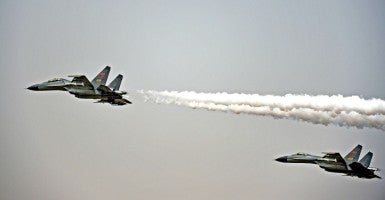To say the bilateral relationship between the United States and the People’s Republic of China is ‘complex’ might just be the ultimate of understatements.
Consider the facts: Beijing and Washington enjoy rich historic and cultural ties that date back generations. Over 300,000 Chinese students today attend American universities, only adding to the richness and cultural diversity of these important institutions. And most important of all, the U.S.-China bilateral trade relationship is worth over $591 Billion and rising.
Bearing in mind how much both sides gain from a productive and strong partnership, many in Washington—and certainly many around the world—hoped that strong ties would serve as a springboard towards Beijing’s “peaceful rise.”
Indeed, China’s economy is now the second largest by measure of gross domestic product (ranked number one if you consider purchasing power parity) and has only fueled hopes of Beijing becoming what is popularly termed a “responsible stakeholder”—that China, with a ‘stake’ in the stability of the international system thanks to strong global economic ties, would follow widely accepted international relations norms and practices.
Cooperation on areas of shared and mutual interest would be emphasized with a clear hope any areas of competition—with a clear understanding that there would be competition in multiple domains—would not derail or weaken what had been accomplished.
Sadly, such hopes have not transcended into reality.
Unfortunately for the United States and its allies in Asia, it seems Beijing has decided to undertake a very different direction in its foreign policy and security goals over the last several years—one that very well undermines the very peace and security Asia has known for decades, the very bedrock of the region’s awe inspiring economic transformation.
In what can only be described as an arch of instability stretching North from the Japanese-administered Senkaku Islands all the way to the very southern edges of the South China Sea and now moving west to what is commonly referred to the Second Island Chain, Beijing has decided that an aggressive policy of slowly but surely weakening the status quo serves its interests.
And Chinese actions clearly demonstrate the above approach. In just the last several years (and far from a comprehensive list), Beijing has sought to enforce lines drawn over vast expanses of the South China Sea along with building islands in this hotly contested area, declared an Air-Defense Identification Zone in the East China Sea without any prior warning along with booting regional allies like the Philippines out of disputed reefs far closer to the Philippines than China.
The goal, many would argue, is to dominate Asia, but more importantly, displace the United States as the preeminent power in the region.
In fact, it now seems America, along with its allies and partners, are slowly moving towards a much more intense security competition with China in the months and years to come, the consequences of which cannot be simply swept aside—especially considering Washington and Beijing both have nuclear weapons.
Sadly, recent headlines only prove Beijing’s aggressive actions throughout the region could spark a superpower clash that has not been seen in decades.
While close monitoring of a military aircraft or naval vessel in international space is certainly a standard practice this interaction was anything but normal. Chinese aviators came within 50 feet of the U.S. plane, prompting the pilot to descend several thousand feet out of safety considerations.
Sound familiar? It should, as China has utilized this playbook before.
In 2014, a Chinese fighter jet came dangerously close to a P-8 U.S. surveillance plane and preformed a barrel roll over it. According to reports, “the Chinese J-11 fighter passed the P-8 Poseidon at 90 degrees, with its belly toward the U.S. aircraft to show off its weapons.”
Thankfully, recent incidents like the ones described above have not led to any injuries or deaths—but that has not always been the case.
Back in 2001, an American EP-3 aircraft collided with a Chinese J-8 fighter jet. The pilot of the J-8 was killed while the U.S. aircraft was forced to undertake an emergency landing in China on Hainan Island. A tense standoff ensued. Thankfully the U.S. crew was released weeks later.
When one considers carefully incidents like the above combined with Beijing’s clear attempts to alter the status quo, it is vital that Washington respond accordingly to not only reinforce America’s commitment to the region but demonstrate clear American leadership.
There are two clear ways to ensure China understands American resolve despite its constant testing of the international order in Asia.
First, Washington must ensure and forge deeper relations with other nations in East Asia—especially important allies. As explained in The Heritage Foundation’s recent Solutions 2016 report:
The U.S. has five treaty allies in the Asia–Pacific region (Japan, South Korea, the Philippines, Australia, and Thailand). The U.S. should be unequivocal in its commitment to mutual defense under these treaties. The U.S. should engage these and other, non-ally nations in the region so that they do not perceive China as the sole game in town.
Also, considering that China is using military instruments of power to push back against America’s place in the region, maintaining a strong U.S. military presence is vital—in fact, it should be strengthened:
U.S. Navy and Coast Guard shipbuilding and modernization programs should be fully funded. The U.S. should also invest in long-range power projection systems (such as unmanned aerial vehicles, bombers, and nuclear attack submarines) and other systems that would counter efforts to deny U.S. forces access to the region or interfere with the freedom of the seas. In addition, the U.S. should maintain robust bases in the region to support U.S. forces.
Clearly the above only serves as a down payment in what can only be part of a comprehensive strategy to ensure China’s rise does not become Asia’s nightmare.
It is clear that only Washington has the power to balance Beijing and keep its increasing assertiveness in check. While America will certainly work with China in areas of cooperation which are certainly vast, Beijing must know Washington will resist any attempts to alter the status-quo while preserving the peace, security and freedom of the Asia-Pacific region.






























